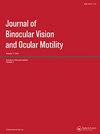Forty-five Years of Studying Intermittent Exotropia — What Have I Learned? The WSPOS Keynote Strabismus Lecture, October 3, 2020
Q3 Medicine
Journal of Binocular Vision and Ocular Motility
Pub Date : 2022-07-03
DOI:10.1080/2576117X.2022.2094176
引用次数: 1
Abstract
ABSTRACT There are three keys to understanding how the new way of classifying and treating intermittent exotropia (IXT) differs from Burian’s classic classification. First, the assumption that lateral rectus surgery selectively affects the distance deviation, recess/resect procedures affect the distance and near equally, and that medial rectus surgery selectively affects the near deviation, are false assumptions. Second, AC/A ratios in IXT can be calculated in all the usual manners, provided that any near measurement used in the calculation be made after prolonged monocular occlusion to eliminate the contaminating effect of the Scobee phenomenon. Third, the use of +3 diopter (D) lenses at near and prolonged monocular occlusion are not interchangeable and work on different mechanisms, the former on accommodative convergence and the latter on fusional convergence. All patients with IXT should have a measurement taken after prolonged monocular occlusion, as well as while fixating on a far distant outdoor target prior to surgery, which should target the largest angle measured.45年来间歇性外斜视的研究——我学到了什么?WSPOS主题演讲斜视,2020年10月3日
要理解间歇性外斜视(IXT)的新分类和治疗方法与Burian的经典分类有何不同,有三个关键。首先,认为腹侧直肌手术选择性地影响距离偏差,隐窝/切除手术对距离和近距离的影响相同,以及内侧直肌手术选择性地影响近距离偏差的假设是错误的。其次,IXT中的AC/A比可以用所有通常的方法计算,只要计算中使用的任何近距离测量都是在长时间单眼遮挡后进行的,以消除Scobee现象的污染效应。第三,+3屈光度(D)镜片在近眼和长时间单眼遮挡下的使用是不可互换的,它们的工作机制不同,前者是调节性会聚,后者是融合性会聚。所有IXT患者均应在长时间单眼遮挡后进行测量,以及在手术前注视远处室外靶标时进行测量,以测量的最大角度为靶标。
本文章由计算机程序翻译,如有差异,请以英文原文为准。
求助全文
约1分钟内获得全文
求助全文
来源期刊

Journal of Binocular Vision and Ocular Motility
Medicine-Ophthalmology
CiteScore
1.20
自引率
0.00%
发文量
42
 求助内容:
求助内容: 应助结果提醒方式:
应助结果提醒方式:


